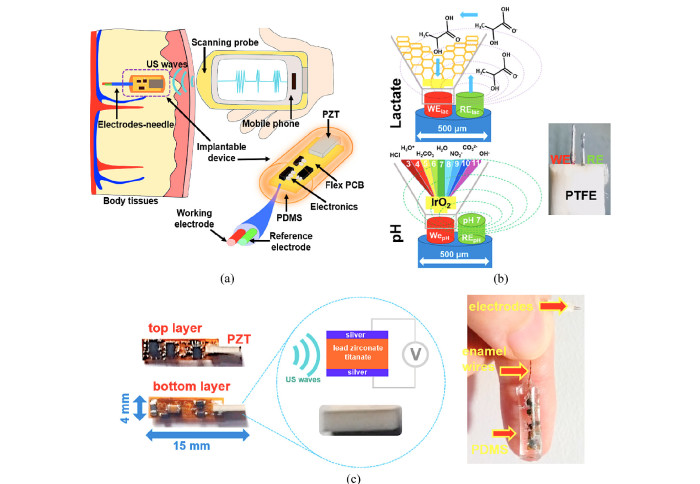Novel Low-powered Implantable Devices for Breast Cancer Soft Tissue Monitoring

Hamlyn researchers presented low-powered implantable devices activated by ultrasonic energy transfer for breast cancer tissue physiological monitoring
As the leading cause of cancer mortality in women worldwide, breast cancer possesses higher concentrations of lactate, nuclear receptors (for estrogen and progesterone), amino acids and choline compounds in comparison to healthy tissue.
However, due to the high tissue heterogeneity, breast cancer profiles can differ significantly among female patients. This creates the barriers for its classification. Moreover, lower rates of long-term breast cancer survival (around 5 years) have been also associated to elevated lactate and glycine levels, making these biomarkers highly attractive for breast cancer prognosis in women.
In addition, the wounds derived from surgical interventions can potentially suffer from pathogen invasion, resulting in tissue infection. Bacteria migration and colonisation to the affected areas brings about alterations to the physiological environment including, among others, local pH changes.
Ultrasounds (US) are one of the most used imaging techniques in medicine for assessing the physiological and pathological state of soft tissue, such as breast cancer detection. Moreover, US can also be used to remotely power implantable devices with sensing capabilities.
It has been proved that an implantable device that is capable of detecting tumour biomarkers with high sensitivity and specificity directly over the target areas (while being completely innocuous to the human body) would be medically advantageous in the diagnosis and evaluation of tumour progression or recession in soft tissues, including the breast.
Novel Low-powered Implantable Devices for Breast Cancer Soft Tissue Physiological Monitoring
In view of this, our researchers at the Hamlyn Centre proposed novel active implantable devices powered by US and data transmission through a Frequency Shift Keying (FSK) modulation technique.
The novel US-powered small-form devices are designed with data exchange capabilities for transmission of parameters (such as pH and lactate levels) in soft tissue via a set of specialised electrochemical electrodes for the detection of pH and lactate levels.

A custom-made piezoelectric transducer is responsible for converting the acoustic waves into electrical voltage at the device with operational levels as low as 0.5 V (power consumption of 10 μW) obtained from implantation distances of 50 mm inside tissue. This conjugated with the high sensitivity of the developed electrochemical sensors allows to detect and transmit local parameter variations below 0.1 pH (4.2 mV) and 1 mM lactate (70 nA).
Excitation of the device is performed by a handheld scanning probe that delivers ultrasonic energy, whereas data transmission in the opposite direction uses backscattering of the acoustic waves encoded by FSK modulation.

The proposed system (implant-electrodes) was evaluated by resorting to a realistic surgical phantom of the breast structure, whose constitutive materials have acoustic properties similar to the real tissues present within the human breast.
The potential applications of the proposed devices include:
- Real-time access to intra-body tissue monitoring post-operatively. As local variations of the previous analytes can provide early indication of tissue infection by bacteria, the proposed devices are aiming to assist the assessment of soft tissue healing and recovery after surgery.
- Tissue cancer screening in structures such as the human breast.
- Moreover, breast surgery reconstruction after free-flap transplantation or cancer can also benefit from the proposed devices as changes in analyte concentration from the normal healthy state are reported.
The final aim of our research team is to integrate such electrochemical sensors with implantable devices in order to provide on-demand assessment of soft tissue parameters in hospital and non-specialist care environments, ultimately at home (since it may benefit the NHS system in the situation of global pandemics, such as current COVID-19 outbreak, where local restrictions are imposed and hospital internment are more difficult to implement in such circumstances).
This research was supported by EPSRC Programme Grant “Micro-robotics for Surgery (EP/P012779/1)” and EPSRC "Smart Sensing for Surgery (EP/L014149/1)" (Bruno Gil Rosa, Salzitsa Anastasova-Ivanova and Guang-Zhong Yang, "Low-powered implantable devices activated by ultrasonic energy transfer for physiological monitoring in soft tissue via functionalized electrochemical electrodes", Biosensors and Bioelectronics, 182, 113175, June 2021).
Article supporters
Article text (excluding photos or graphics) © Imperial College London.
Photos and graphics subject to third party copyright used with permission or © Imperial College London.
Reporter
Erh-Ya (Asa) Tsui
Enterprise